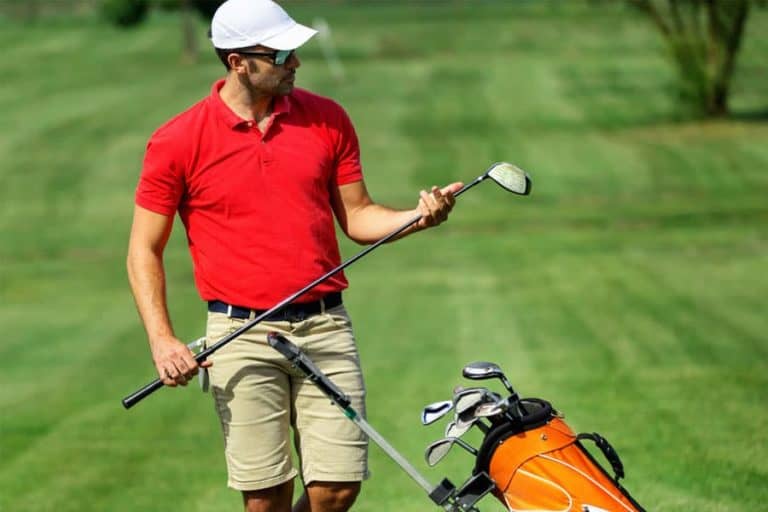Golf Shank: What Is It, Causes, And Ways To Fix It

Learn about what a golf shank is? and Its cause with simple tips to fix it. Improve grip, stance, and swing for better shots. Regain confidence on the course.
Golf shank is a dreaded term among golfers and can disrupt the smoothest swings. It is essential for any golfer to understand its cause and master the techniques to avoid it, which is crucial for a consistent and enjoyable golf game.
I. What is a Golf shank?
A golf shank occurs when the golf ball hits the hosel of the club instead of the club face. This results in a mis-hit where the ball travels off to the right (for right-handed golfers) at a 45-degree angle.
This commonly occurs when the golfers lose control of their swing, and the club hits the ball off-center or behind the club’s face. This is a common problem among amateur golfers.
Although it can be frustrating, understanding how and why shanks occur can help you avoid them in future rounds of the golf game.
II. Types of Shank
Even the best golfers have hit the occasional shank. Different kinds of shanks can occur while playing golf. Let’s explore some of the most common types of shanks seen on the golf course.
- The in-to-out shank
The in-to-out shank is also known as the “better player” shank or the “heel” shank. This golf shank happens when your clubhead is swinging on a too-shallow path, an inside-to-out path that brings the hosel close to the ball.
How to fix: To fix this, you can steepen your downswing and move your path more leftward by tilting your spine towards the ground at the address.
Doing this will create a steeper shoulder turn and allow your arms to go higher, pulling the hosel away from the ball.
- The over-the-top shank/ outside-in
The “outside-in” shank is often caused by the clubhead path becoming too steep, resulting in the heel moving across your target line.
How to fix: To combat this problem temporarily, you may need to work on swallowing your swing. However, getting a lesson with an experienced coach is always best to ensure you hit perfect shots.
III. Causes of golf shanks
Shanks occur due to various reasons and they are:
1. Standing too close
Standing too close to a golf ball can lead to the club making contact with the hosel during the downswing. The correct stance and setup play a vital role in preventing this. If your lower body rotation is not optimal, making a simple adjustment by moving slightly away from the ball can effectively resolve this issue.
2. Unstable grip
Your grip on the golf club is crucial. Some players hold the club so lightly that it shifts in their hands during the swing, which can lead to issues. Start by ensuring you have a proper, neutral golf grip.
3. Your weight is on your toes
During a swing, golfers should evenly distribute their weight on their feet. Leaning too far forward with weight on the toes not only messes up the swing and leads to shanking but also increases the risk of physical injury.
4. Swing path issues
Swing path problems are the main cause of shanks. Often, the club swings too far inside, making contact near the hosel during the impact. Alternatively, a shank can result from a golf swing that is excessively over the top, especially for the average right-handed golfer.
IV. Step to avoid golf shank
Now that you know why the ball sometimes goes off course, let’s explore some of the best ways to fix it:
1. Fix your stance and posture
Good posture is key to preventing shanks and is crucial for your overall swing and rotation.
For a solid shot, ensure that your body is aligned from head to toe. Keep your weight evenly distributed in your feet, maintaining a slight bend in your knees without locking them.
If you find yourself reaching too far for the ball, adjust your stance and get closer. Avoid bending too much, and keep your arms close but not cramped.
2. Feet together swings
Trying a golf swing with your feet together might feel a bit unusual at first, but it’s a simple yet effective drill. It lets you maintain balance and naturally encourages the correct distance for your club swing.
Start by hitting some shots with your feet together, ensuring they go straight. Gradually transition back to your standard golf stance once you feel comfortable and confident.
3. Check your grip
Ensure you hold your club properly. Avoid gripping it too tightly, but make sure there’s no room for the club to move around during your swing.
To check your grip pressure, place some grass on top of your left thumb and between the club’s butt and the pad of your left hand. If the grass stays in place during your swing, your grip pressure is good. If it falls, your grip might be too light.
4. Take half swings
If you’re dealing with shanks, another effective drill is to take half swings to reset and eliminate the issue. Often, a shank happens due to a slight variation in your usual golf swing. By condensing to a half swing, you can concentrate on achieving solid contact and fixing the problem.
5. Line up your hands
Ensure that your hands are in line with your target at the moment of impact. The back of your left hand and the palm of your right hand should align with the direction you want the ball to go.
This proper hand alignment is crucial for achieving the desired shot. It helps in maintaining control and directing the ball accurately toward your intended target.
6. Low grip pressure
When you’re shanking the ball, it often leads to increased grip pressure, creating stress during your game. To address this, it’s crucial to reduce the pressure in both your left and right hand.
Loosening your grip is essential to regain control and improve your golf swing. If you find yourself shanking, take a moment to adjust your grip pressure, and it can make a significant difference in your performance.
Conclusion
While fixing a golf shank may take some time and practice, it is possible with the right techniques and drills. It is important to be patient and consistent with practice, as it can take time to see improvement. With the right mindset and dedication, any golfer can improve their shank and take their game to the next level.
FAQs
1. What Is The Difference Between A Shank And A Slice In Golf?
A shank occurs when the club’s hosel is the first to make contact with the ball, resulting in a shot that veers drastically right, left, or straight toward the player. A slice is when the ball curves away from the player due to an out-to-in swing path. Both shots can be improved by working on one’s golf mechanics, such as grip pressure and swing path.
2. Is A Shank Close To A Good Shot?
No, a shank is far from a good shot. It can also be one of the most challenging shots to correct due to the drastic changes in the ball flight it creates. If a player is consistently shanking the ball, they must figure out what could be causing them to hit the hosel first and work on correcting that issue.
3. What is the opposite of shank in golf?
A whiff in golf is the opposite of a shank, and it happens when you completely miss the ball during your swing.








